The global mini POS terminals market is projected to grow from USD 120.9 million in 2025 to approximately USD 200.7 million by 2035, recording an absolute increase of USD 79.8 million over the forecast period. This translates into a total growth of 66.0%, with the market forecast to expand at a compound annual growth rate (CAGR) of 5.2% between 2025 and 2035. The overall market size is expected to grow by nearly 1.7X during the same period, supported by increasing adoption of cashless payment systems, rising demand for portable payment solutions, and growing focus on contactless transaction technologies in small and medium businesses.
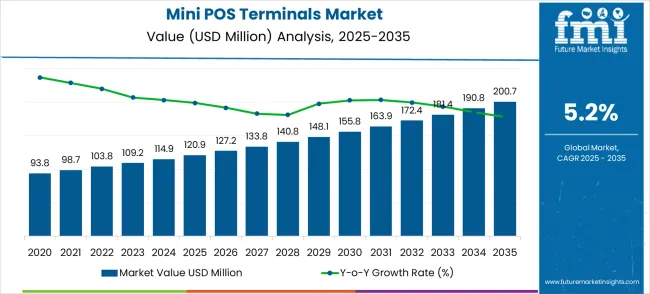
Between 2025 and 2030, the mini POS terminals market is projected to expand from USD 120.9 million to USD 156.4 million, resulting in a value increase of USD 35.5 million, which represents 44.5% of the total forecast growth for the decade. This phase of growth will be shaped by rising adoption of digital payment technologies, increasing demand for mobile payment solutions in small businesses, and growing penetration of contactless payment systems in emerging markets. Payment technology companies are expanding their mini POS capabilities to address the growing demand for affordable and versatile payment processing solutions for micro and small enterprises.
| Metric | Value |
|---|---|
| Estimated Value in (2025E) | USD 120.9 million |
| Forecast Value in (2035F) | USD 200.7 million |
| Forecast CAGR (2025 to 2035) | 5.2% |
From 2030 to 2035, the market is forecast to grow from USD 156.4 million to USD 200.7 million, adding another USD 44.3 million, which constitutes 55.5% of the overall ten-year expansion. This period is expected to be characterized by expansion of omnichannel payment solutions, integration of advanced security features with mini POS systems, and development of cloud-based payment management platforms. The growing adoption of fintech innovations and digital transformation initiatives will drive demand for sophisticated mini POS terminals with enhanced connectivity and multi-payment acceptance capabilities.
Between 2020 and 2025, the mini POS terminals market experienced significant expansion, driven by increasing recognition of digital payment benefits for small businesses and growing acceptance of portable payment solutions in various service sectors. The market developed as merchants recognized the need for cost-effective payment processing solutions to meet customer demands for cashless transactions. Digital transformation and contactless payment initiatives began emphasizing the importance of mini POS systems in achieving comprehensive payment acceptance and business modernization objectives.
Market expansion is being supported by the increasing demand for cashless payment solutions and the corresponding need for affordable and portable payment processing technologies for small and medium enterprises. Modern merchants and service providers are increasingly focused on payment systems that can accept multiple payment methods, provide instant transaction processing, and enable business mobility through compact form factors. The proven effectiveness of mini POS terminals in reducing transaction costs and improving customer convenience makes them essential tools for competitive business operations.
The growing emphasis on digital transformation and contactless payments is driving demand for advanced mini POS systems that address evolving consumer payment preferences and regulatory requirements. Payment industry preference for integrated solutions that combine payment processing with business management features is creating opportunities for innovative product development. The rising influence of fintech innovations and mobile commerce is also contributing to increased adoption of proven mini POS terminals across different business sectors and merchant categories.
The mini POS terminals market is moving into an accelerated adoption curve, driven by retail digitization, small business fintech integration, and the rising penetration of contactless and omnichannel payment ecosystems. By 2035, these pathways together unlock USD 75–90 million in incremental revenue opportunities beyond baseline growth.
Pathway A – Retail Digitization & Omnichannel Expansion Mini POS terminals integrated with inventory management, CRM, and omnichannel platforms for retailers moving to unified commerce models. Largest pool: USD 25–28 million.
Pathway B – Catering, QSR & Hospitality Payment Solutions Compact, mobile POS systems enabling fast, contactless transactions in restaurants, cafés, and delivery/takeaway models. Expected pool: USD 15–18 million.
Pathway C – Emerging Market Merchant Inclusion Affordable mini POS terminals designed for micro-merchants and SMEs in India, ASEAN, Africa, and Latin America, supporting government-led financial inclusion. Incremental pool: USD 14–16 million.
Pathway D – Security & Compliance-Driven Terminals Mini POS with advanced encryption, PCI-DSS compliance, and tokenization for merchants in regulated sectors (healthcare, financial services, government). Opportunity pool: USD 10–12 million.
Pathway E – Cloud & AI-Enabled Payment Management Cloud-linked mini POS devices with AI-powered fraud detection, predictive analytics, and remote fleet management. Smaller but high-value pool: USD 8–10 million.
The market is segmented by terminal type, application, and region. By terminal type, the market is divided into with printer and without printer configurations. Based on application, the market is categorized into retail, catering, and other sectors. Regionally, the market is divided into North America, Europe, East Asia, South Asia & Pacific, Latin America, and Middle East & Africa.
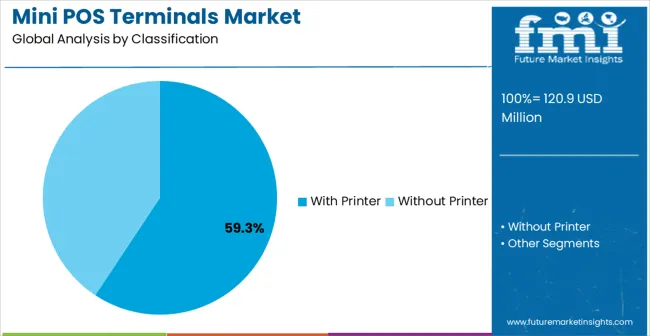
The with printer segment is projected to account for 59.3% of the mini POS terminals market in 2025, reaffirming its position as the category's dominant terminal type. Merchant operators increasingly recognize the operational advantages of integrated printer functionality for receipt generation and transaction documentation, particularly their ability to provide complete transaction records and customer service capabilities. This terminal type addresses both payment processing requirements and documentation needs, providing comprehensive transaction management for diverse business applications.
This terminal type forms the foundation of most traditional retail operations, as it represents the most complete and customer-service oriented approach in payment processing technology. Technical validation studies and extensive merchant feedback continue to strengthen confidence in printer-integrated terminal capabilities. With increasing recognition of the importance of transaction documentation requiring integrated printing solutions, with printer terminals align with both current merchant requirements and customer service standards. Their comprehensive functionality across multiple business scenarios ensures sustained market dominance, making them the central growth driver of mini POS terminals demand.
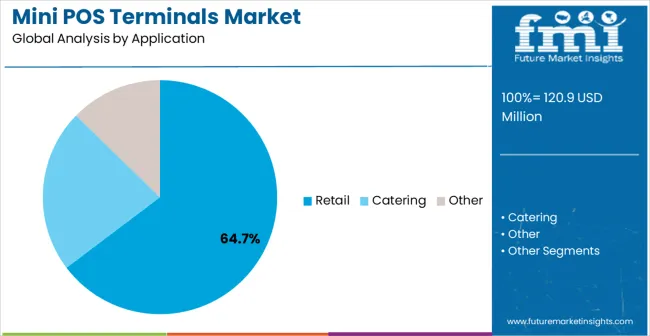
Retail applications are projected to represent 64.7% of mini POS terminals demand in 2025, underscoring their role as the primary application driving terminal adoption. Retail merchants and store operators recognize that retail environments require versatile payment processing systems that can effectively handle diverse transaction types and customer payment preferences. Mini POS terminals offer optimal performance characteristics for point-of-sale operations, inventory management integration, and customer service applications across various retail formats and business sizes.
The segment is supported by the massive digitization of retail operations requiring modern payment infrastructure and the growing recognition that portable payment solutions provide superior operational flexibility for retail businesses. Additionally, retail merchants are increasingly adopting integrated commerce approaches that leverage mini POS advantages for optimal customer experience and operational efficiency. As retail continues to evolve toward more sophisticated payment acceptance and omnichannel operations, payment systems optimized for retail applications will continue to play a crucial role in competitive merchant strategies, reinforcing their essential position within the payment processing market.
The mini POS terminals market is advancing steadily due to increasing demand for cashless payment solutions and growing adoption of portable payment processing technologies in small and medium businesses. However, the market faces challenges including intense price competition, complex regulatory compliance requirements, and concerns about cybersecurity and data protection. Innovation in payment technologies and security features continue to influence product development and market expansion patterns.
The growing development of digital payment ecosystems is enabling more sophisticated payment processing requirements and merchant service needs. Digital payment expansion requires comprehensive terminal capabilities, including multi-payment acceptance, real-time processing, and integrated business management, that advanced mini POS terminals can provide effectively. Fintech innovation creates demand for payment technologies that can support diverse business models while ensuring security and regulatory compliance.
Modern payment companies are incorporating contactless technologies such as NFC, QR code payments, and mobile wallet integration to enhance mini POS terminal capabilities. These technologies improve transaction speed, enable better customer convenience, and provide enhanced payment security and fraud prevention capabilities. Advanced contactless integration also enables optimized payment flows and early adoption of emerging payment methods and digital currencies.
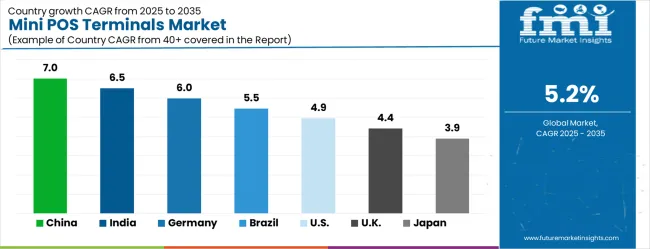
| Country | CAGR (2025-2035) |
|---|---|
| China | 7% |
| India | 6.5% |
| Germany | 6% |
| Brazil | 5.5% |
| USA | 4.9% |
| UK | 4.4% |
| Japan | 3.9% |
The mini POS terminals market is experiencing varied growth globally, with China leading at a 7.0% CAGR through 2035, driven by rapid digital payment adoption, increasing small business modernization, and growing government support for cashless economy initiatives. India follows at 6.5%, supported by digital payment infrastructure expansion, increasing merchant digitization programs, and expanding fintech sector development. Germany shows growth at 6.0%, emphasizing advanced payment technologies and established retail industry modernization. Brazil records 5.5% growth, focusing on improved digital payment infrastructure and small business technology adoption. The USA shows 4.9% growth, representing a mature market with established payment processing companies and ongoing technology advancement initiatives.
The report covers an in-depth analysis of 40+ countries, the top-performing countries are highlighted below.
The mini POS terminals market in China is projected to exhibit robust growth with a CAGR of 7% through 2035, driven by massive digital payment ecosystem expansion and increasing domestic demand for portable payment solutions. The country's rapidly evolving retail landscape and expanding small business sector are creating significant opportunities for mini POS terminal adoption. Major international and domestic payment technology companies are establishing comprehensive manufacturing and distribution networks to serve the growing demand for affordable payment processing solutions across retail and service sectors.
The mini POS terminals market in India is expanding at a CAGR of 6.5%, supported by increasing digital payment infrastructure development, growing merchant adoption of cashless systems, and expanding fintech sector presence. The country's large small business market and increasing adoption of digital payment technologies are driving demand for cost-effective payment processing solutions. International payment companies and domestic manufacturers are establishing supply networks to serve the growing demand for accessible payment terminal technologies.
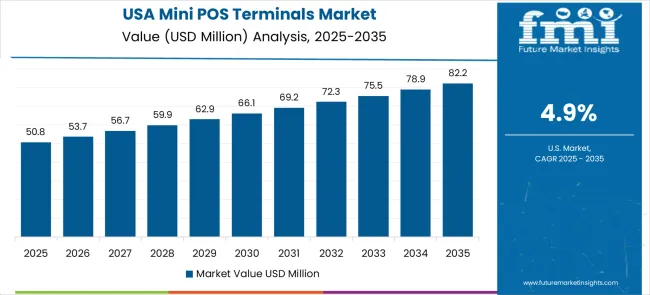
The mini POS terminals market in the United States is projected to grow at a CAGR of 4.9%, supported by well-established payment processing infrastructure and comprehensive merchant service requirements. American retailers and service providers consistently utilize advanced payment technologies for competitive customer service and operational efficiency. The market is characterized by mature payment ecosystems, comprehensive security standards, and established relationships between merchants and payment service providers.
The mini POS terminals market in Brazil is projected to grow at a CAGR of 5.5% through 2035, driven by payment infrastructure modernization, increasing small business digital adoption, and growing recognition of cashless payment benefits. Brazilian merchants and service providers are increasingly adopting modern payment system approaches for competitive business operations, supported by expanding payment infrastructure and improved technology accessibility.
The mini POS terminals market in Germany is projected to grow at a CAGR of 6% through 2035, supported by established retail industry leadership, advanced payment technology requirements, and comprehensive digital commerce frameworks. German retailers and service providers consistently utilize cutting-edge payment systems as part of integrated business operations, emphasizing customer service excellence and technological innovation.
The mini POS terminals market in the United Kingdom is projected to grow at a CAGR of 4.4% through 2035, supported by comprehensive payment industry requirements and established fintech innovation leadership that facilitate appropriate use of advanced payment systems for diverse business applications. British merchants and service providers consistently utilize proven protocols for payment system implementation, emphasizing operational efficiency and customer service within integrated business operations.
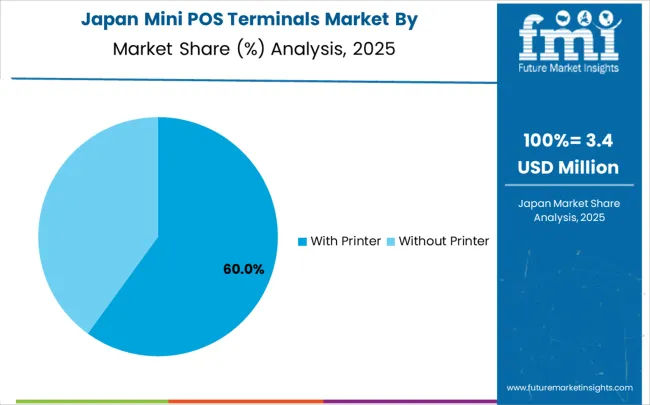
The mini POS terminals market in Japan is projected to grow at a CAGR of 3.9% through 2035, supported by the country's advanced payment technology infrastructure, comprehensive retail standards, and systematic approach to payment system optimization. Japanese retailers and service providers emphasize precision-engineered payment system utilization within structured business frameworks that prioritize customer service and operational excellence.
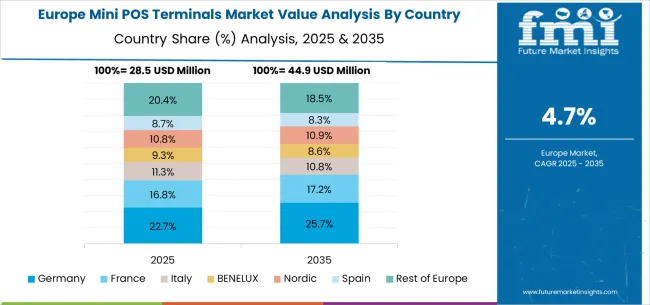
The mini POS terminals market in Europe is projected to expand steadily through 2035, supported by increasing adoption of cashless payment systems, rising demand for portable payment solutions, and ongoing innovation in payment processing technologies. Germany will continue to lead the regional market, accounting for 24% in 2025 and rising to 24.8% by 2035, supported by strong retail industry infrastructure, advanced payment technology capabilities, and robust digital commerce initiatives. The United Kingdom follows with 17.6% in 2025, increasing to 18.2% by 2035, driven by comprehensive payment industry standards, fintech innovation leadership, and expanding merchant payment capabilities.
France holds 15.4% in 2025, edging up to 15.9% by 2035 as retailers expand payment system utilization and demand grows for advanced payment processing solutions. Italy contributes 12.9% in 2025, remaining broadly stable at 13.4% by 2035, supported by growing retail sector investment and increasing payment technology adoption. Spain represents 10.7% in 2025, inching upward to 11.1% by 2035, underpinned by strengthening retail infrastructure and payment system modernization initiatives.
BENELUX markets together account for 8.8% in 2025, moving to 9.2% by 2035, supported by advanced payment requirements and fintech innovation initiatives. The Nordic countries represent 6.3% in 2025, marginally increasing to 6.5% by 2035, with demand fueled by comprehensive digital payment adoption and early implementation of advanced payment technologies. The Rest of Western Europe moderates from 4.3% in 2025 to 0.9% by 2035, as larger core markets capture a greater share of payment technology investment, retail modernization projects, and mini POS terminal adoption.
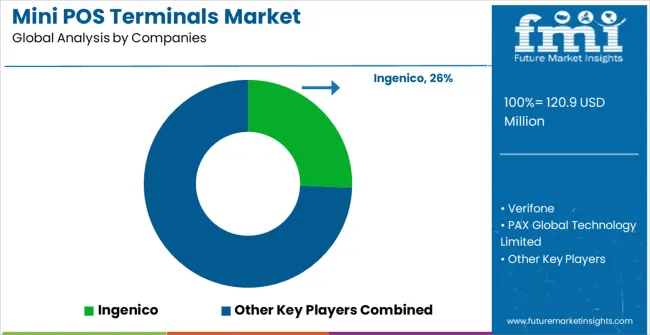
The mini POS terminals market is characterized by competition among established payment technology companies, specialized terminal manufacturers, and comprehensive payment solution providers. Companies are investing in product research and development, technology advancement, strategic partnerships, and merchant support services to deliver reliable, secure, and cost-effective mini POS terminal solutions. Product innovation, payment security, and market access strategies are central to strengthening product portfolios and market presence.
Ingenico leads the market with comprehensive payment solutions focusing on technology innovation and merchant service excellence. Verifone provides extensive payment terminal portfolios with emphasis on security and global market presence. PAX Global Technology Limited focuses on innovative payment technologies and cost-effective terminal solutions for diverse merchant applications. Fujian Newland Payment Technology Co., Ltd delivers advanced terminal designs with strong performance characteristics and technical support.
Castles Technology operates with focus on specialized payment terminals and merchant-focused solutions for comprehensive business applications. Fujian MoreFun Electronic Technology, Shenzhen Xinguodu Technology, and UROVO provide comprehensive terminal portfolios with emphasis on affordability and functionality optimization. Landi and ZCS deliver specialized solutions including merchant services, technical consulting support, and payment processing assistance to enhance market accessibility and customer satisfaction across diverse retail and service environments.
| Items | Values |
|---|---|
| Quantitative Units (2025) | USD 120.9 million |
| Terminal Type | With Printer, Without Printer, Other |
| Application | Retail, Catering, Other |
| Regions Covered | North America, Europe, East Asia, South Asia & Pacific, Latin America, Middle East & Africa |
| Countries Covered | United States, Canada, United Kingdom, Germany, France, China, Japan, South Korea, India, Brazil, Australia and 40+ countries |
| Key Companies Profiled | Ingenico, Verifone, PAX Global Technology Limited, Fujian Newland Payment Technology Co., Ltd, Castles Technology, Fujian MoreFun Electronic Technology, Shenzhen Xinguodu Technology, UROVO, Landi, ZCS |
| Additional Attributes | Dollar sales by terminal type and application, regional demand trends, competitive landscape, merchant preferences for specific features, integration with payment systems, innovations in payment processing, security enhancement strategies, and operational efficiency optimization |
The global mini POS terminals market is estimated to be valued at USD 120.9 million in 2025.
The market size for the mini POS terminals market is projected to reach USD 200.7 million by 2035.
The mini POS terminals market is expected to grow at a 5.2% CAGR between 2025 and 2035.
The key product types in mini POS terminals market are with printer and without printer.
In terms of application, retail segment to command 64.7% share in the mini POS terminals market in 2025.






Our Research Products

The "Full Research Suite" delivers actionable market intel, deep dives on markets or technologies, so clients act faster, cut risk, and unlock growth.

The Leaderboard benchmarks and ranks top vendors, classifying them as Established Leaders, Leading Challengers, or Disruptors & Challengers.

Locates where complements amplify value and substitutes erode it, forecasting net impact by horizon

We deliver granular, decision-grade intel: market sizing, 5-year forecasts, pricing, adoption, usage, revenue, and operational KPIs—plus competitor tracking, regulation, and value chains—across 60 countries broadly.

Spot the shifts before they hit your P&L. We track inflection points, adoption curves, pricing moves, and ecosystem plays to show where demand is heading, why it is changing, and what to do next across high-growth markets and disruptive tech

Real-time reads of user behavior. We track shifting priorities, perceptions of today’s and next-gen services, and provider experience, then pace how fast tech moves from trial to adoption, blending buyer, consumer, and channel inputs with social signals (#WhySwitch, #UX).

Partner with our analyst team to build a custom report designed around your business priorities. From analysing market trends to assessing competitors or crafting bespoke datasets, we tailor insights to your needs.
Supplier Intelligence
Discovery & Profiling
Capacity & Footprint
Performance & Risk
Compliance & Governance
Commercial Readiness
Who Supplies Whom
Scorecards & Shortlists
Playbooks & Docs
Category Intelligence
Definition & Scope
Demand & Use Cases
Cost Drivers
Market Structure
Supply Chain Map
Trade & Policy
Operating Norms
Deliverables
Buyer Intelligence
Account Basics
Spend & Scope
Procurement Model
Vendor Requirements
Terms & Policies
Entry Strategy
Pain Points & Triggers
Outputs
Pricing Analysis
Benchmarks
Trends
Should-Cost
Indexation
Landed Cost
Commercial Terms
Deliverables
Brand Analysis
Positioning & Value Prop
Share & Presence
Customer Evidence
Go-to-Market
Digital & Reputation
Compliance & Trust
KPIs & Gaps
Outputs
Full Research Suite comprises of:
Market outlook & trends analysis
Interviews & case studies
Strategic recommendations
Vendor profiles & capabilities analysis
5-year forecasts
8 regions and 60+ country-level data splits
Market segment data splits
12 months of continuous data updates
DELIVERED AS:
PDF EXCEL ONLINE
Miniplate for Bone Fixation Market Size and Share Forecast Outlook 2025 to 2035
Miniature Electrochemical CO Sensor Market Size and Share Forecast Outlook 2025 to 2035
Mini LED Solder Pastes and Fluxes Market Size and Share Forecast Outlook 2025 to 2035
Miniature Duplex Connectors Market Size and Share Forecast Outlook 2025 to 2035
Mining Lubricant Market Size and Share Forecast Outlook 2025 to 2035
Mining Remanufacturing Component Market Forecast Outlook 2025 to 2035
Mining Hose Market Size and Share Forecast Outlook 2025 to 2035
Mining Equipment Industry Analysis in Latin America Size and Share Forecast Outlook 2025 to 2035
Mining Tester Market Size and Share Forecast Outlook 2025 to 2035
Mini Cranes Market Size and Share Forecast Outlook 2025 to 2035
Mining Pneumatic Saw Market Size and Share Forecast Outlook 2025 to 2035
Mini Grid Market Size and Share Forecast Outlook 2025 to 2035
Mini Track Machinery Market Size and Share Forecast Outlook 2025 to 2035
Minimally Invasive Spine Technologies Market Size and Share Forecast Outlook 2025 to 2035
Mining Drilling Service Market Size and Share Forecast Outlook 2025 to 2035
Mini Hair Straightener Market Size and Share Forecast Outlook 2025 to 2035
Minimally Invasive Laser Therapy Devices Market Size and Share Forecast Outlook 2025 to 2035
Mining Trucks Market Size and Share Forecast Outlook 2025 to 2035
Mini Drives Market Analysis Size and Share Forecast Outlook 2025 to 2035
Mini Packaging Market Size, Growth, and Forecast for 2025-2035

Thank you!
You will receive an email from our Business Development Manager. Please be sure to check your SPAM/JUNK folder too.
Chat With
MaRIA